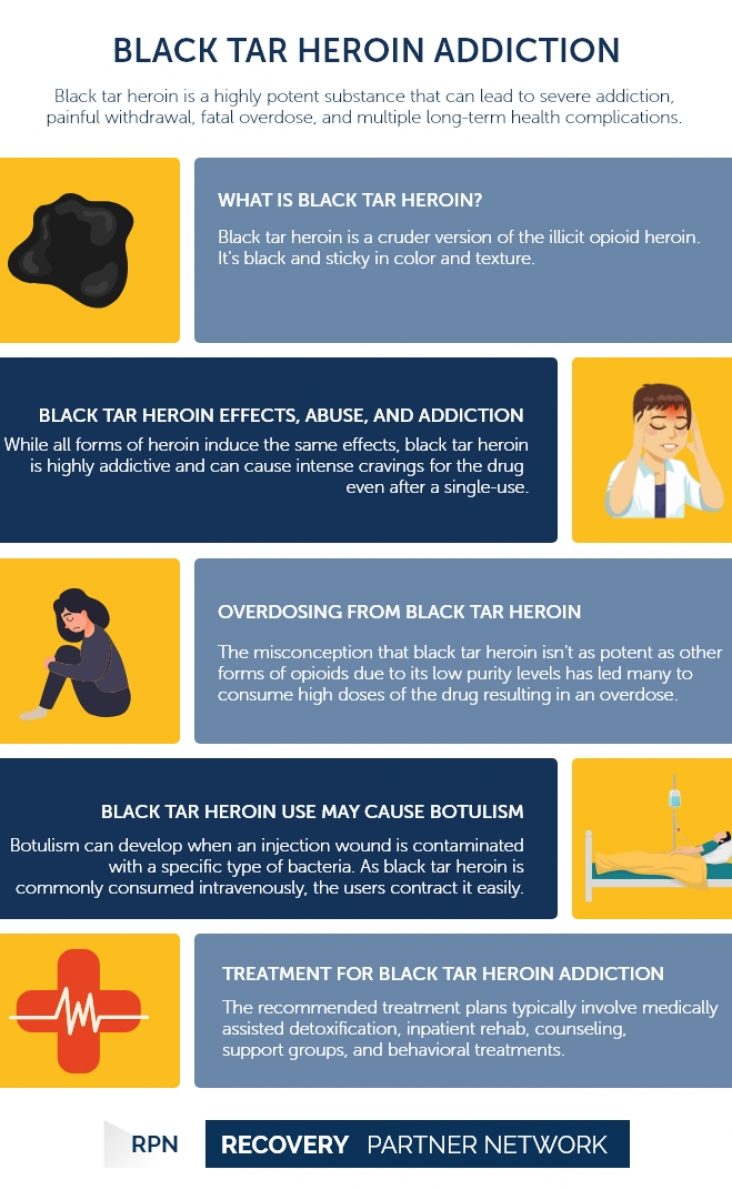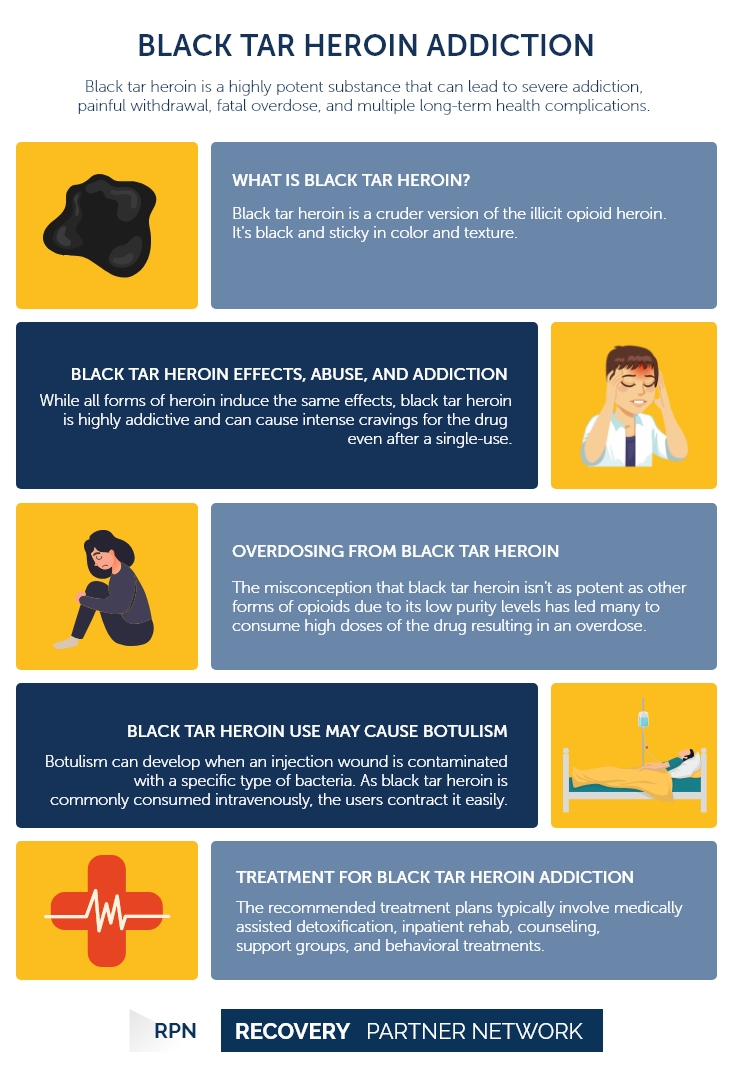Black tar heroin is a highly potent substance that can lead to severe addiction, painful withdrawal, fatal overdose, and multiple long-term health complications.
Black Tar Heroin Addiction
Illicit drugs
- Ayahuasca addiction – Abuse
- Baclofen addiction
- Black tar heroin addiction
- Cannabis addiction
- Cocaine dependence
- Crack cocaine addiction
- DMT addiction abuse treatment
- Does Marijuana Kill Brain Cells?
- Ecstasy addiction
- Gabapentin addiction
- gamma-Hydroxybutyric acid addiction
- Hallucinogen
- Heroin addiction
- Illicit drug addiction
- Inhalant addiction
- Cocaine
- Ketamine addiction
- Lysergic acid diethylamide addiction
- Mescaline addiction
- Methamphetamine addiction
- Meth Labs: Cooking up Addiction
- Meth Mouth
- Microdosing
- Phencyclidine addiction
- Psilocybin mushroom addiction
- Sage of the diviners – Addiction
- Shooting Heroin
- Shooting Methamphetamine
- Smoking Cannabis
- Speedball
- Synthetic cannabinoids
Black tar heroin addiction | Table of Contents
What is Black Tar Heroin?
Black tar heroin is a cruder version of the illicit opioid, heroin. It’s black and sticky in color and texture. The substance is usually sold in chunks weighing around an ounce. The drug is also known as heroin acetate, as the substance is produced after the refinement process known as acetylation.
The drug is often referred to as Mexican black tar heroin, as it is a major export for Mexican traffickers. The New York State Office of Addiction Services and Supports (OASAS) has reported that black tar heroin is mainly manufactured in Mexico using rudimentary processing methods. Black tar heroin is usually much cheaper compared to other opioids and widely available throughout the west Mississippi river in the US and Canada.
FAQ
- What regions produce black tar heroin?
- What are the health risks of black tar heroin?
- The effects of black tar heroin?
Black tar heroin is mostly produced in Mexico.
A major percentage of black tar heroin contains contaminants and additives that are toxic that can easily block blood vessels and significantly increase the risk of damaging the liver, brain, lungs, and kidneys. Other health risks of using black tar heroin include venous sclerosis, tetanus, wound botulism, abscesses, necrotizing fasciitis, overdose, and death.
Black tar heroin can induce a feeling of euphoric high when consumed. It can also induce intense cravings even after a single-use.
Black Tar Heroin Effects, Abuse, and Addiction
All forms of heroin induce the same effects when consumed. Black tar heroin is a highly addictive substance that can cause intense cravings for the drug even after a single-use. The crude and sticky nature of black tar heroin cannot be intravenously injected until it is dissolved in a solvent. This is typically carried out by heating the substance over a flame. This drug is most commonly consumed through injecting or smoking. Although black tar heroin is generally very low in purity, its capacity to form dependence and addiction remains very high.
The short-term effects of black tar heroin are:
- Flushed skin
- Heavy limbs
- Dry mouth
- Drowsiness
- Euphoria
- Intense itching
- Nausea and vomiting
Mentioned below are some long-term effects of heroin use:
- Addiction
- Insomnia
- Collapsed veins (from intravenous use)
- Damaged tissue (where the drug is ingested)
- Infection of the heart lining and valves
- Abscesses (swollen tissue filled with pus)
- Constipation and stomach cramps
- Liver and kidney disease
- Lung disease
- Mental disorders
- Erectile dysfunction in men
- Irregular menstrual cycles in women
Most heroin users initially start off by forming an addiction to prescription opioids. In fact, research shows that 80 percent of users addicted to heroin initially found themselves addicted to opioids that were prescribed by their doctors. The prolonged consumption of such medications led to the formation of dependence tolerance and addiction among patients. Such patients eventually find themselves drawn to heroin as it is easier to get hold of and cheaper to acquire.
Given below are some symptoms of heroin addiction:
- Bloodshot eyes
- Sudden weight loss
- Secretive behavior
- Changes in appearance
- Lack of motivation
- Extreme drowsiness or nodding off
- Financial problems, borrowing money
- Depression
- Constipation
- Slurred speech
- Paranoia
- Shortness of breath
- Collapsed veins
- Severe itchiness
- Nausea and vomiting
Overdosing from Black Tar Heroin
The common misconception that black tar heroin isn’t as potent as other forms of opioids due to its low levels of purity has led many to consume high doses of the drug in the hopes of achieving the desired effect. This misunderstanding has contributed to a large number of overdose commonly experienced by heroin users.
Although overdose symptoms are generally not fatal, they do have the potential to be so if not treated quickly. When an individual exhibits signs of an overdose, prompt usage of naloxone (Narcan) will alleviate the effects and stop an overdose from reaching fatal consequences. Naloxone is an opioid antagonist used to block or counteract the symptoms of opioid medications.
Adverse effects of black tar heroin overdose include:
- Shallow or no breathing
- Low blood pressure
- Weak pulse
- Dry mouth
- Tongue discoloration
- Pinpoint pupils
- Slow pulse
- Bluish lips and nails
- Stomach or intestinal spasms
- Delirium
- Disorientation or confusion
- Passing out
- Uncontrollable muscle movements
- Extreme drowsiness
Black Tar Heroin Use May Cause Botulism
Botulism is a rare neurological disease that can develop when an injection wound is contaminated with a specific type of bacteria. If left untreated, this disease can cause difficulty in swallowing, blurred vision, trouble breathing, paralysis, and death. Many heroin users find themselves contracting this disease as the drug is most commonly consumed intravenously. Although there is no known cure for botulism, symptoms can be managed with appropriate medical care.
In 2017, a report published in the Journal of Neurocritical Care examined 15 patients in El Paso, Texas. They were admitted to the hospital for botulism and had a history of black tar heroin use. Researchers, later on, concluded that injecting the drug under the skin was connected with developing botulism.
Treatment for Black Tar Heroin Addiction
Black tar heroin abuse treatment typically involves medically assisted detoxification, counseling, support groups, and behavioral treatments. The initial stage of all addiction treatment involves detoxification. During this process, patients are prescribed medications to help alleviate withdrawal symptoms.
Mentioned below are some of the medications used in any heroin addiction treatment:
Methadone is a slow-acting opioid that reduces feelings of euphoria and helps the individual not experience heroin withdrawal symptoms. This medication is only available via outpatient testament care.
This medication reduces the effects of black tar heroin for several days. Suboxone is a common brand of buprenorphine that can be ingested orally or sublingually.
A non-addictive drug that stops the impact of opioids. Research has reported that individuals struggling with an addiction to black tar heroin are less likely to comply with this treatment method compared to other treatment choices. However, naltrexone is effective when used as medically prescribed.
In addition to the medications mentioned above, behavioral treatments, including contingency management and cognitive behavioral therapy, are also vital in the treatment of heroin addiction. Contingency management provides positive reinforcements and the control of stimulus to adjust and correct problematic behaviors connected to addiction. Cognitive-behavioral therapy helps individuals be aware, identify, understand, and change these behaviors.
Therapy is often a significant aspect of uncovering and treating underlying behaviors that led to addiction. Therapy can also help to treat any traces of co-occurring disorders that may be present. Patients who wish to quit black tar heroin are highly advised to seek specialized medical treatment at an inpatient treatment center due to its severity.
Recovery Partner Network
We aim to educate and empower. If you feel our library of resources does not cover your specific need, reach out to us, and we would be happy to help.
STATISTICS
© Copyright 2025


